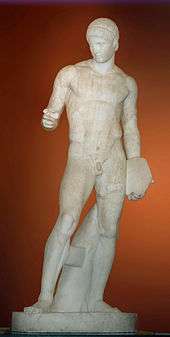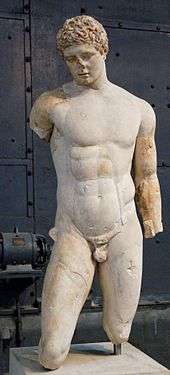Discophoros

The Discophoros, also spelled Discophorus, (Greek - "Discus-Bearer") was a bronze sculpture by the classical Greek sculptor Polyclitus, creator of the Doryphoros and Diadumenos, and its many Roman marble copies. (It is not, however, to be confused with Discobolus of Myron, which shows a discus being thrown, not carried.)
Like the Doryphoros and Diadumenos, it was created as an example of Polyclitus's "canon" of the ideal human form in sculpture. It features a young, muscular, solidly-built athlete in a moment of thought before throwing a discus. Most marble copies feature the addition of a marble tree stump - marble is weaker but heavier than bronze- as the stump is needed for support. These copies are also often missing their arms, which are often restored.

A variant is at the Louvre Museum.
References
| Wikimedia Commons has media related to Discophoros. |
- Borbein, Adolf. "Polykleitos", in O. Palagia and J.J. Pollitt, eds, Personal Styles in Greek Sculpture (Yale Classical Studies XXX) (Cambridge University Press) 1998:66-90. Summarizing traditional attributions.
- Herbert Beck, Peter C. Bol, Maraike Bückling (Hrsg.): Polyklet. Der Bildhauer der griechischen Klassik. Ausstellung im Liebieghaus-Museum Alter Plastik Frankfurt am Main. Von Zabern, Mainz 1990 ISBN 3-8053-1175-3
- Detlev Kreikenbom: Bildwerke nach Polyklet. Kopienkritische Untersuchungen zu den männlichen statuarischen Typen nach polykletischen Vorbildern. "Diskophoros", Hermes, Doryphoros, Herakles, Diadumenos. Mann, Berlin 1990, ISBN 3-7861-1623-7